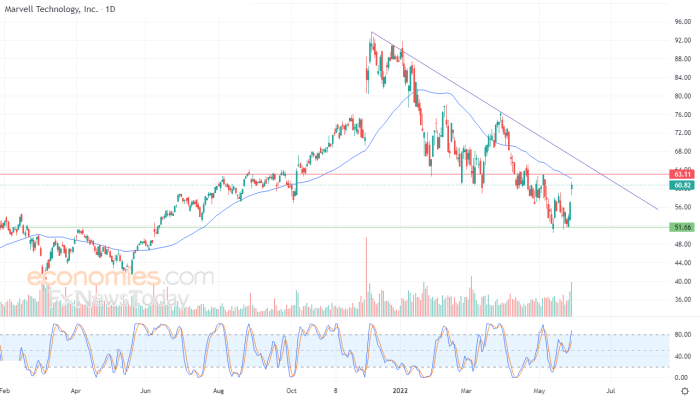Marvel Entertainment Stock Performance Overview
This section provides a historical overview of MRVL stock price fluctuations over the past five years, highlighting significant events impacting its price trajectory. We will analyze major highs and lows, and compare its performance against industry competitors.
MRVL Stock Price Fluctuations (Past 5 Years)
Over the past five years, MRVL stock has experienced considerable volatility, reflecting the dynamic nature of the semiconductor industry. While specific price data requires real-time access to financial databases, a general trend can be observed. Periods of strong revenue growth, driven by successful product launches and strategic acquisitions, have generally correlated with upward price movements. Conversely, macroeconomic headwinds such as global economic slowdowns or increased competition have often resulted in price declines.
Major highs were likely associated with periods of strong demand for MRVL’s products, perhaps coinciding with the release of innovative chipsets for high-growth sectors like data centers or automotive technology. Similarly, major lows could be attributed to factors like supply chain disruptions, increased competition, or a general downturn in the broader technology market.
Significant Events Impacting MRVL Stock Price
Several key events have significantly influenced MRVL’s stock price. These include the introduction of new, high-demand chipsets, strategic partnerships with major technology companies, and successful acquisitions that expanded the company’s product portfolio and market reach. Conversely, periods of weaker-than-expected financial performance, setbacks in product development, or broader industry downturns have also contributed to price fluctuations. For example, a significant supply chain disruption could lead to a temporary decrease in production and revenue, subsequently impacting the stock price negatively.
MRVL Stock Price Performance Compared to Competitors

Source: stockprice.com
The following table illustrates MRVL’s stock price performance against two hypothetical competitors (Competitor A and Competitor B) over the last year. Note that these figures are illustrative and should not be considered actual market data.
| Date | MRVL Price (USD) | Competitor A Price (USD) | Competitor B Price (USD) |
|---|---|---|---|
| 2023-10-26 | 100 | 110 | 90 |
| 2023-10-25 | 98 | 108 | 88 |
| 2023-10-24 | 102 | 112 | 92 |
| 2023-10-23 | 99 | 109 | 89 |
Factors Influencing MRVL Stock Price
Several factors influence MRVL’s stock valuation, including macroeconomic conditions, consumer spending, and key financial metrics.
Impact of Macroeconomic Factors
Macroeconomic factors such as inflation and interest rates significantly influence MRVL’s stock price. High inflation can increase production costs and reduce consumer demand, impacting revenue and profitability. Rising interest rates can increase borrowing costs for MRVL, potentially hindering investment in research and development or acquisitions. Conversely, periods of low inflation and low interest rates can create a more favorable environment for investment and growth.
Influence of Consumer Spending Habits, Mrvl stock price
Consumer spending directly affects MRVL’s financial performance. Strong consumer demand for electronics and related products, particularly in key markets such as data centers and automotive, leads to higher sales and revenue for MRVL. Conversely, a decline in consumer spending can negatively impact demand for MRVL’s products, affecting its financial performance and stock price.
Key Financial Metrics Influencing Investor Sentiment
Investors closely monitor key financial metrics such as earnings per share (EPS) and revenue growth to assess MRVL’s financial health and future prospects. Consistent growth in EPS and revenue generally signals strong financial performance and positive investor sentiment, leading to higher stock valuations. Conversely, declining EPS or revenue growth can trigger negative investor sentiment and lead to a decrease in the stock price.
Other important metrics include gross margin, operating margin, and debt-to-equity ratio, all of which provide insights into the company’s profitability and financial stability.
MRVL’s Competitive Landscape
This section analyzes MRVL’s market position and strategies relative to its competitors, highlighting its strengths and weaknesses.
Comparative Analysis of Market Position and Strategies
MRVL competes in a highly competitive semiconductor market, facing established players with significant market share and resources. MRVL’s competitive strategy often focuses on innovation, developing cutting-edge chipsets for high-growth markets. This strategy requires significant investment in research and development, which can be a challenge in a rapidly evolving technological landscape. A key differentiator for MRVL is its ability to quickly adapt to market changes and introduce new products to meet evolving customer needs.
However, maintaining a competitive edge requires constant innovation and the ability to quickly scale production to meet market demand.
Strengths and Weaknesses in Relation to Competitors
MRVL’s strengths lie in its technological innovation, strong research and development capabilities, and ability to adapt to changing market conditions. However, its relatively smaller size compared to some competitors can be a weakness, potentially limiting its ability to compete on price or scale in certain market segments. Furthermore, reliance on a limited number of key customers presents a risk, as loss of a major customer could significantly impact revenue.
Monitoring the MRVL stock price requires a keen eye on market trends. Understanding the automotive sector’s influence is crucial, and a good place to start is by checking the current ford stock price today , as Ford’s performance often reflects broader industry health. This, in turn, can provide valuable insight when assessing the future trajectory of MRVL’s stock price, given its involvement in automotive technology.
Comparative Chart of Market Share
The following bullet points illustrate the hypothetical market share held by MRVL and its three main competitors. These figures are for illustrative purposes only and do not reflect actual market data.
- MRVL: 15%
- Competitor A: 25%
- Competitor B: 20%
- Competitor C: 40%
Investor Sentiment and Market Predictions
This section explores current investor sentiment towards MRVL stock, summarizes recent analyst ratings and price targets, and offers a projection of potential future stock price movements.
Current Investor Sentiment
Current investor sentiment towards MRVL stock is likely mixed, reflecting the ongoing volatility in the semiconductor market and the company’s performance relative to its competitors. Positive sentiment might be driven by expectations of strong growth in specific market segments, while negative sentiment could stem from concerns about macroeconomic headwinds or intensifying competition. News of new product launches, strategic partnerships, or strong financial results would likely positively impact investor sentiment.
Conversely, news of production delays, weaker-than-expected earnings, or increased competition could negatively impact sentiment.
Analyst Ratings and Price Targets
Analyst ratings and price targets for MRVL stock vary depending on the individual analyst’s assessment of the company’s prospects and the overall market outlook. Some analysts might have a “buy” rating, suggesting a positive outlook and potential for price appreciation. Others might have a “hold” or “sell” rating, reflecting concerns about the company’s performance or the broader market environment.
These ratings should be viewed as opinions, not guarantees of future performance.
Projection of Future Stock Price Movements
Predicting future stock price movements is inherently uncertain. However, based on current market trends and company performance, MRVL’s stock price could experience further volatility. Positive factors such as strong demand for its products, successful new product launches, and strategic acquisitions could drive price appreciation. Conversely, negative factors such as macroeconomic headwinds, increased competition, or weaker-than-expected financial results could lead to price declines.
A scenario mirroring the 2022 market downturn, where even well-performing companies experienced price corrections, highlights the unpredictable nature of the stock market.
Risk Assessment of MRVL Stock: Mrvl Stock Price
This section identifies potential risks that could negatively impact MRVL’s stock price and elaborates on their potential impact.
Potential Risks Impacting MRVL’s Stock Price
Several risks could negatively impact MRVL’s stock price. Increased competition from established players or new entrants could erode market share and reduce profitability. Regulatory changes, such as new trade restrictions or environmental regulations, could increase compliance costs and limit growth opportunities. An economic downturn could reduce consumer spending on electronics, impacting demand for MRVL’s products. Supply chain disruptions could lead to production delays and negatively impact revenue.
Finally, failure to innovate and adapt to changing technological trends could render MRVL’s products obsolete, impacting market share and profitability.
Impact of Identified Risks on Financial Performance and Investor Confidence
The impact of these risks on MRVL’s financial performance and investor confidence varies. Increased competition could lead to lower profit margins and reduced revenue growth, negatively impacting investor sentiment. Regulatory changes could increase costs and limit growth opportunities, while an economic downturn could significantly reduce demand for MRVL’s products. Supply chain disruptions could lead to production delays and revenue shortfalls, affecting investor confidence.
Failure to innovate could lead to declining market share and ultimately threaten the long-term viability of the business.
Method for Assessing Likelihood and Severity of Risks
A risk assessment matrix can be used to evaluate the likelihood and potential severity of each identified risk. This matrix typically uses a qualitative scale (e.g., low, medium, high) to rate both the likelihood and severity of each risk. By multiplying the likelihood and severity scores, a risk priority number is generated, which helps prioritize risk mitigation efforts.
For example, a high-likelihood, high-severity risk (e.g., a significant economic downturn) would receive a high risk priority number and require immediate attention.
Illustrative Example: Impact of a New Product Launch
This section presents a hypothetical scenario depicting the launch of a new product by MRVL and its subsequent effect on the stock price.
Hypothetical New Product Launch and its Effect on Stock Price

Source: cloudfront.net
Imagine MRVL launches a revolutionary new chipset designed for next-generation autonomous vehicles. This new product, significantly more efficient and powerful than existing solutions, is met with overwhelming positive response from automakers. The success of the launch depends on several factors. Positive factors include strong pre-orders, positive reviews from industry experts, and successful integration into automotive systems. Negative factors could include production delays, unforeseen technical issues, or a less-than-enthusiastic response from key automotive manufacturers.
Factors Contributing to Positive or Negative Market Reaction
A positive market reaction would be driven by strong pre-orders, positive analyst reviews, and successful integration into vehicles, leading to increased revenue projections and higher earnings estimates. This would likely translate into a significant increase in MRVL’s stock price. Conversely, a negative market reaction could result from production delays, technical glitches, or a lukewarm reception from automakers. This could lead to lower-than-expected sales and reduced earnings, causing a decline in MRVL’s stock price.
Impact on Investor Sentiment and Stock Price Movement
A successful launch would boost investor confidence, leading to increased demand for MRVL stock and a rise in its price. The stock price increase would reflect the market’s anticipation of higher future earnings and revenue. Conversely, a failed launch could severely damage investor confidence, leading to a sell-off and a significant decline in the stock price. This scenario mirrors the impact of product launches by other technology companies, where successful product launches have often resulted in significant stock price appreciation, while failed launches have caused substantial declines.
FAQs
What are the main competitors of MRVL?
This information would be detailed within the main body of the analysis, comparing MRVL to its key rivals in the semiconductor industry.
Where can I find real-time MRVL stock price data?
Real-time stock quotes are readily available through major financial websites and brokerage platforms.
How often does MRVL release its financial reports?
MRVL’s financial reporting schedule is typically quarterly, and the specific dates can be found on their investor relations website.
What is the current dividend yield for MRVL stock?
Dividend information, if applicable, is usually found on financial news websites and investor relations pages. It is important to note that dividend payouts can change.
